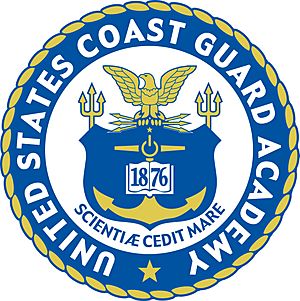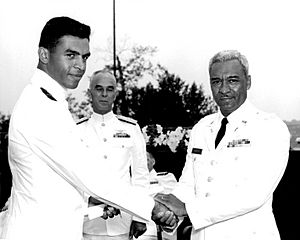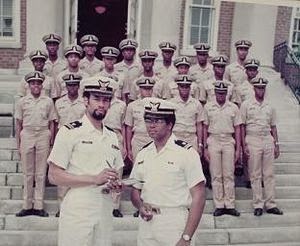Black cadets at the United States Coast Guard Academy facts for kids
 |
|
|
Former names
|
Revenue Cutter Service School of Instruction (1876) |
|---|---|
| Motto | Scientiæ Cedit Mare (Latin) |
|
Motto in English
|
The sea yields to knowledge |
| Type | U.S. Service Academy |
| Established | 1876 |
| Superintendent | Rear Admiral William G. Kelley (USCGA 1987) |
| Dean | Capt. (ret.) Kurt J. Colella |
| Commandant | Capt. Rick Wester (USCGA 1993) |
|
Academic staff
|
130 |
| Students | 1045 cadets (as of September 2019) |
| Location |
,
,
U.S.
41°22′22″N 72°06′06″W / 41.37278°N 72.10167°W |
| Campus | Suburban - 110 acres (44.5 ha) |
| Fight song | "Semper Paratus" |
| Colors | Blue & orange |
| Nickname | Bears |
|
Sporting affiliations
|
NCAA Division III - NEWMAC NEFC |
| Mascot | Objee the Bear |
The United States Coast Guard Academy is a special school. It trains young people to become officers in the U.S. Coast Guard. It was started in 1876. Back then, it was called the U.S. Revenue Cutter Service School of Instruction.
The Academy made history in 1966. That year, Merle Smith became its first African-American graduate. Before 1962, only one African-American cadet, Javis Wright, had been admitted. He had to leave because of health issues.
The Coast Guard Academy is unique among federal military academies. You don't need a special appointment from a member of Congress to get in. Admission is based on your grades and activities. Each year, about 200 to 300 new cadets join. The whole school usually has around 1,000 cadets.
Contents
First African-American Cadets at the Academy
In the 1950s and 1960s, leaders wanted to make sure all parts of American life were fair. President Harry S. Truman had already ended segregation in the armed forces in 1948. But military academies were slower to include everyone.
President John F. Kennedy wanted to change this. He encouraged the U.S. Coast Guard Academy to welcome black high school students. This was part of a bigger effort to create more equal opportunities.
Early African-American Cadets
In 1955, Javis Leon Wright, Jr. joined the Coast Guard Academy. He was a talented athlete. He competed on the track and cross-country teams. His fellow cadets liked him.
Sadly, in 1957, Javis had serious health problems. He had to leave the Academy. The superintendent, Rear Admiral Frank Leamy, was sad to see him go. He said Javis had the qualities needed for an officer.

In June 1962, Merle James Smith, Jr. was admitted. He worked hard and made history. In June 1966, he became the first African-American to graduate from the Academy.
More black cadets joined after that. In 1964, London Steverson and Kenneth D. Boyd were admitted. They were part of the Class of 1968.
It was tough to graduate from the Academy. Many cadets left before finishing. But both London Steverson and Kenneth Boyd completed their four years. They graduated in 1968.
Challenges and Progress
The first black cadets faced difficulties. The Coast Guard officer group was almost entirely white in 1964. Many officers were not used to working with black students or leaders. This made it challenging for the new graduates.
For example, Kenny Boyd faced problems at his first duty station. He had to leave his ship early. London Steverson also faced challenges in his career. He was promoted to lieutenant commander but did not get further promotions for a long time. He had to retire after 20 years of service.
Despite these challenges, progress was made. In 1994, Captain Joseph Jones became the first black officer to command a large Coast Guard cutter, the Dallas. Later, in 2009, Captain Aaron Davenport commanded the USCGC Jarvis.
Building Bridges for Future Cadets
In 1972, Lieutenant London Steverson took on a new role. He became the Chief of the Minority Recruiting Section. This section was at Coast Guard Headquarters in Washington, D.C.
His job was to help bring more diverse students to the Academy. From 1876 until 1962, almost no African-American cadets had been admitted. London Steverson changed that.
He recruited more than 50 minority cadets in just two years (1973-1974). He traveled across the country. He met with parents and students. He attended events for groups like the NAACP.
He also started a "Sponsor Program." Current officers would connect with promising applicants. This helped keep students interested in the Academy. He also arranged trips for students and their families to visit the campus.
His efforts paid off. In his first year, 28 African-American students joined the Academy. The next year, another 20 joined. These efforts helped bring in future leaders. Two of these recruits, Rear Admiral Erroll M. Brown and Vice Admiral Manson K. Brown, later became admirals.
Many Historic Firsts
African-American graduates of the Coast Guard Academy have achieved many important "firsts."
- 1966 - Merle James Smith became the first African-American to graduate from the Academy.
- 1977 - Bobby C. Wilks became the first African-American to be promoted to the rank of captain.
- 1978 - Manson K. Brown (Class of '78) became the first black regimental commander at the Academy. This was a big leadership role for a cadet.
- 1980 - Joseph Jones (Class of '72) became the first commanding officer of a newly built Coast Guard cutter, the USCGC NEAH BAY.
- 1983 - Angela Dennis and Daphne Reese became the first black female graduates of the Coast Guard Academy.
- 1988 - Commander Merle Smith and Lieutenant Commander London Steverson were the first African-American graduates to retire from the Coast Guard.
- 1994 - Joseph Jones (Class of '72) became the commanding officer of a large cutter, the USCGC DALLAS.
- 1998 - Erroll M. Brown (Class of '72) became the first black admiral in the Coast Guard.
- 2005 - Lieutenant (Junior Grade) Jeanine McIntosh became the first black female Coast Guard aviator (pilot).
- 2007 - Cadet DeCarol Davis became the first African-American cadet and the first cadet ever to receive the Truman Scholarship. This is a very important national award.
- 2010 - Manson K. Brown (Class of '78) was promoted to vice admiral.
- 2014 - Vice Admiral Manson K. Brown retired. He is the highest-ranking African-American to have served in the Coast Guard so far.
Programs for Future Cadets
The Coast Guard Academy has special programs to encourage diverse students to apply.
Eclipse Diversity Weekend
This event brings together high school students who have been accepted to the Academy. It also includes Academy graduates and current cadets. It's a two-day celebration of diversity. African-American alumni return to meet with students and offer advice. Guests stay overnight in the cadet dorms.
Super Saturday
This program is designed for students from underrepresented groups and their families. It happens three times a year. Guests learn about the Academy, ask questions, and take a tour. They also get to eat lunch with the cadets.


